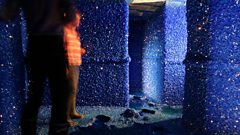Crystals
Crystals are found growing naturally all over the world, and are among the oldest things on earth, so why are we creating new ones for the purposes of art and science?
Bridget Kendall discusses the incredibly varied uses and meanings of crystals with cave scientist Penny Boston, whose work takes her deep underground to study ancient life forms trapped inside the earth's largest crystals; biophysicist Elspeth Garman who, with the help of robots, can spend years growing one perfect protein crystal in her lab; and artist Roger Hiorns who has encrusted many objects with sparkling blue copper sulphate crystals, including the entire interior of a derelict London bedsit.
(Photo: Liberata; taken by Giovanni Badino © SpeleoResearch&Film-LaVenta-C/Producciones)
Last on
Penlope Boston

Penny Boston is Professor of Cave and Karst Science at New Mexico Tech. Her areas of research include microbial life in highly mineralized environments and astrobiology and the search for life beyond Earth. She visited the in Mexico in 2008 and 2010, to search for ancient DNA trapped within and around the giant mega-crystals discovered there.�� Visits to the system, 300 metres underground, involve wearing an ice suit, and must be limited to an hour because of the 50 degree heat, and 100% humidity.�� Penny has grown more than 80 cultures in her lab from the samples she took at Naica, and she says the emerging results suggest that the crust of the earth could be acting as a kind of geological genome bank; holding on to organisms that are taken out of circulation and then re-introducing them at a later date.��
And you can see some photos taken at Naica / Ojo la Reina in Mexico by Penny Boston and others by clicking on the Gallery on the right of this page
Roger Hiorns

Roger Hiorns is a British artist who has exhibited widely in the UK and internationally.�� He has a number of works in public collections including the Tate, the Museum of Modern Art in New York and the Art Institute of Chicago.�� Roger was nominated for the prestigious Turner Prize in 2009. His piece Seizure was created in 2008, by pumping over 70,000 litres of liquid copper sulphate into a derelict apartment. When drained, a sparkling blue crystalline growth was left on the walls, floor, ceiling and bath of the abandoned dwelling. Faced with demolition in early 2011, the piece was acquired by the , and transported to Yorkshire Sculpture Park, where it has just gone on display.��
And you can see some photos from Roger Hiorns Seizure piece at the Yorkshire Sculpture Park by clicking onto the Gallery on the upper-right of this page.
��Elspeth Garman

Professor Elspeth Garman heads the Garman Group, part of the Laboratory of Molecular Biophysics at Oxford University.�� With the help of robots, Elspeth grows thousands of protein crystals in her lab, in the search for one perfect, pure, microscopically small crystal to use. Elspeth and her team then blast the crystal with x-ray photons in order to work out the protein’s structure and function.�� They have ‘solved’ many proteins using these techniques, most recently an enzyme from the cell wall of the tuberculosis mycobacteria (arylamine N-acetyltransferase).�� They also focus on developing improved methods for macromolecular crystallography, including studies on how to reduce radiation damage of crystals.���� Elspeth conducts many of her experiments at the Diamond Light Source synchrotron in Oxfordshire, which has an x-ray beam 100 billion times more intense than the sun.
Broadcast
- Sat 31 Aug 2013 11:0091�ȱ� Radio 4


